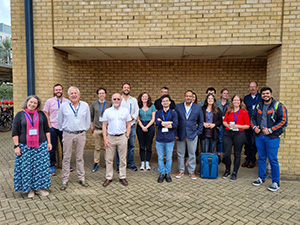
Members of the LiFT project team in Southampton. © BGS / UKRI. Image credit: Kathryn Goodenough.
In late-August 2023 the LiFT research teams, plus some key external partners, met at the National Oceanographic Centre in Southampton for a research in progress workshop. The workshop was well attended despite train strikes and competition from several high-profile conferences taking place the same week! The overall aim of the workshop was to establish the key links between the different WPs and how this information can be used to develop a model of the geological lithium cycle.
Day one started with a welcome from Martin Palmer (Southampton), followed by an introduction from Kathryn Goodenough (BGS). Stefan Debruyne of SQM gave an overview of current activities at the Salar de Atacama lithium operation in Chile, including the work they are doing to improve the environmental footprint and sustainability of lithium extraction. This included information about their recent IRMA (Initiative for Responsible Mining Assurance) audit. A series of presentations were given by CSM researchers in WP4, including life cycle assessment (LCA) of water budgets by Rowan Halkes, bioleaching work by Becca Kirk and Mohammed Rehmanji and work by Alastair Skeffington on microbial communities in salars. After lunch presentations were given on the work happening in WP1, this included work by Jafar Al-Jawad (BGS) on modelling the key components (e.g. precipitation, altitude) required to form salars. Max Thiemens of Edinburgh presented results from lab-based leaching experiments conducted on volcanic rocks a salar catchment.
Day two opened with a review of discussions from day one. There were presentations by Francesco Putzolu (NHM) and Marie Lefebvre-Desanois (Southampton) describing the ongoing work in WP2 on sedimentary-hosted lithium deposits. Francesco described the detailed mineralogical processes that take place when forming volcano-sedimentary lithium deposits, while Marie talked about the use of Li and B isotopes in understanding the formation of lithium-bearing borate deposits. The final session of the workshop was focused on lithium-bearing granites and pegmatites (WP3). Work on Li-granites in South West England was presented by Francesco, this was followed by a presentation on the complex parageneses observed in lithium-pegmatites by Richard Shaw (BGS).
Over the two days there were many valuable discussions allowing those all-important links between WPs to be made. Many thanks to Martin Palmer and Marie Lefebvre-Desanois for organising the workshop.
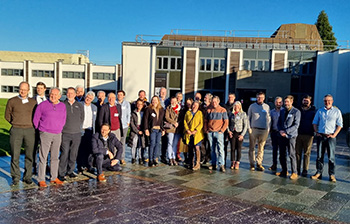
Members of the LiFT project team in Keyworth. © BGS / UKRI. Image credit: Kathryn Goodenough.
The LiFT project held its second hybrid project meeting on 14-15 December 2022. Despite a spate of illnesses and poorly timed train strikes 34 people attended the meeting in-person at the British Geological Survey headquarters in Nottingham, with a smaller number taking part online. Participants included the LiFT project team, project partners, advisory board members and several other invited guests. The meeting was chaired by LiFT PI Kathryn Goodenough from the BGS.
The meeting opened with a lithium industry overview from Anthony Alderson of Benchmark Minerals that highlighted China's current dominance in the production of EVs and batteries. He also highlighted the shift toward increasing demand from the battery industry by 2030 and diversification of lithium supply across the same timeframe. This was followed by a talk from Ulric Schwela of the International Lithium Association (ILiA) explaining ILiA's vision is to represent the lithium industry through education and advocacy, while promoting ESG and sustainability. Rob Pell of Minviro provided a pre-recorded talk on life cycle analysis (LCA) applied to lithium projects and how this can be used to compare the environmental footprint of different types of lithium deposit. Melisa Olivelli of the University of Argentina talked about the microbiological research currently be undertaken on South American salars and how this can be used to improve understanding of biogeochemical cycling in salar brines. The final talk of the first day was given by Corrado Torre of SQM where he provided a detailed overview of the operational situation at Salar de Atacama (Chile) and the company's future plans, including those related to achieving high-environmental and sustainability standards.
The day was followed by a meal at the famous Trent Bridge Cricket Ground in Nottingham.
Day two started with WP1 talks from Max Thiemens (Edinburgh University) and Jafar Al-Jawad (BGS). Max provided an overview of recent fieldwork in South America and the samples that were collected and the laboratory work that is planned (e.g. leaching experiments). Jafar talked about the modelling work undertaken at BGS looking to understand controls, such as precipitation and altitude, on salar formation at several different scales (e.g. regional scale and basin scale). Next were presentations on the research being undertaken in WP2, firstly Marie Lefebvre-Desanois (Southampton University) talked about lithium deposits in Western Antolia that was followed by Francesco Putzolu (NHM) describing work on lithium in volcano-sedimentary systems. WP3 was represented by talks from Francesco Putzolu (NHM) on lithium enrichment in mica in Cornish granites and from Richard Shaw (BGS) about the complex paragenesis observed in lithium pegmatites and what that means for lithium ore minerals. Rowan Halkes (CSM) and Alastair Skeffington (CSM) presented research from WP4 on life cycle analysis (LCA) applied to water use in salar-hosted lithium deposits and the microbiology of salars, respectively. The day finished with a useful panel discussion, where feedback was given by members of the advisory board.
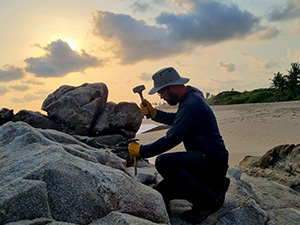
Sampling lithium-pegmatites in Ghana. © BGS / UKRI. Image credit: Kathryn Goodenough.
In November 2022 Kathryn Goodenough and Richard Shaw were joined by a team of geologists from the University of Ghana, the University of Mines at Tarkwa, the Ghana Geological Survey Authority, Atlantic Lithium and a colleague from the University of Toulouse on their fieldwork in Ghana. During our two-week trip we undertook a sampling transect from Winneba in the east to Cape Coast in the west, collecting almost 100 kilograms of material in total. The purpose of the trip was to collect samples that would help us to answer the question - what type of source material do you need to melt to form lithium-enriched pegmatites?
The geology of the Ghanaian coast around Winneba and Cape Coast is dominated by post-orogenic granitoids and a series of roughly NE-SW-trending Palaeoproterozoic metavolcanic belts and highly deformed metasedimentary basins. There are also smaller bodies of granite that crop out in the study area that have received very little attention to date. In the study area there are numerous pegmatites, of varying chemistry and mineralogy, for example at Ewoyaa the pegmatites are spodumene-dominated, whereas at Mankwadzi (less than 20 kilometres west of Winneba) they are dominated by tourmaline, cassiterite and coltan (columbite-tantalite). The distribution is not always clear, but it broadly seems that the most lithium-rich pegmatites are hosted by metasedimentary rocks, whilst those hosted by metavolcanic rocks are enriched in boron, tin and tantalum.
We aim to use whole-rock lithogeochemistry and tracer isotopes to try and establish if there is any link between the granitoids, pegmatites and country rocks in the study area. This will hopefully help us to answer the question about what rock types melt to produce the parental magmas for lithium pegmatites.
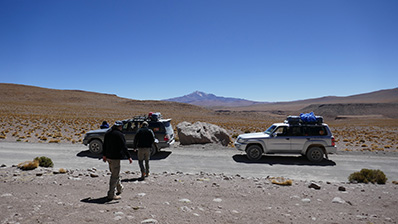
Fieldwork in the Lithium Triangle, South America. © / image credit: Rowan Halkes.
In the Autumn of 2022, a LiFT project team from the British Geological Survey (BGS), the University of Exeter, the University of Edinburgh and the National University of General San Martín undertook a trip to the Lithium Triangle in South America. The Lithium Triangle hosts most of the world's known lithium reserves within its salar deposits, the aim was to better understand how these salar systems formed and work - from the macro to microbial scale - following up on a reconnaissance visit earlier in the year by BGS.
The team assembled in Santiago, Chile where they met with SQM to discuss the LiFT project and collaboration before travelling up to the High Andes. Firstly stopping at San Pedro de Atacama and visiting the Salar de Atacama. Following this the team split, some travelling to Antofagasta while others ventured across the border into Bolivia and the watershed of Salar de Uyuni. They progressively worked their way through the watershed down to Uyuni itself. Our time in Uyuni included a visit to the salar and Incahuasi Island, not always possible due to the wet season, with the team then moving on to La Paz to finish the trip.
The trip enabled partners across the LiFT project to enhance their understanding, refine theories, develop connections and networks as well as return to locations previously identified. The trip will also be invaluable for informing future work in the region. With thanks to BGS for their coordination and leading of the trip and SQM for their collaboration.
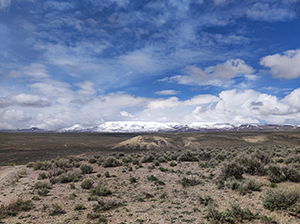
Looking westwards towards Disaster Peak over the extent of the Jindalee McDermitt Li-clay deposit. The pale yellow hills in the mid-ground represent the mineralised units. © Natural History Museum.
The NHM team visited the Northern part of the McDermitt Caldera (Oregon, USA) in the period between the 22nd of April and the 3rd of May 2022. The purpose of this visit was to examine and sample one of the deposit styles within the large group of volcano-sedimentary lithium-bearing systems.
The McDermit Caldera is a 16.85 Ma old volcanic centre that straddles the Nevada - Oregon State border and is the earliest volcanic centre related to the Yellowstone Hotspot. It hosts the large Lithium Clay deposit of Thacker Pass, currently under development by Lithium America. The NHM investigated the Jindalee McDermitt Project located in the north-western Area of the Caldera. The current geological standing shows that Thacker Pass and Jindalee McDermitt deposits are hosted within a series of intra-caldera lacustrine units deposit shortly after the resurgent phase of the Caldera (ca. 15 Ma ago).
Our work focused on developing a deeper understanding of the 'architecture of the lithium trap' in this style of mineralization. The lithium resource is held within a range of clay minerals classified as smectites. Observations from the field and of drill core, demonstrate that geological history of these ephemeral lake systems is dynamic with phases of quiescence disrupted by higher energy sedimentation events as the caldera evolved. The integration of lithological logging with mineralogy and geochemistry suggest that the Jindalee McDermitt mineralization is the result of the interplay of the favourable structural and geomorphological setting, primary Li enrichment in the volcanic rocks and transient alkaline diagenetic conditions. Key to the preservation of the McDermitt Caldera style lithium deposits are post-depositional processes, which may upgrade or destroy the Li contents.
NHM and LiFT would like to thank Jindalee Resources for access to their licence area.
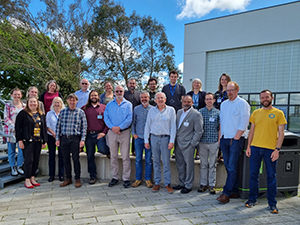
Members of the LiFT project team in Cornwall. © BGS / UKRI.
In mid-May 2022, the research teams of the LiFT project, together with a couple of key project partners, gathered in Cornwall for a project meeting. On the first day, British Lithium kindly welcomed some of the team to their site at Roche, where we were able to view their operating pilot plant and study some core from the zinnwaldite granite that is the key part of their deposit.
On the next day, the whole LiFT research team gathered in Falmouth and set off to meet Cornish Lithium for a tour of their sites. We started at ESAM, near St Austell, where we had an introductory talk about Cornish Lithium before viewing zinnwaldite granite core from their Trelavour hard-rock project. We then visited Trelith, where the processing pilot plant will be sited. Our final stop of the day was United Downs, where Cornish Lithium has drilled deep boreholes and is now testing different Direct Lithium Extraction (DLE) technologies for extraction of the lithium from geothermal waters. We were able to study the borehole core, and to see the operating DLE pilot plant.
The third day of the meeting was dedicated to a workshop for the research teams, based at Camborne School of Mines (CSM). Several of the researchers within the project gave talks about their ongoing research. Jafar Al-Jawad (British Geological Survey) described his work to develop a typology for the salars in South America. Max Thiemens (University of Edinburgh) gave an overview of lithium isotope systems, followed by Marie Lefebvre-Desanois (University of Southampton) who described ‘palaeo-salar’ systems in Turkey and Serbia. Francesco Putzolu (Natural History Museum) talked about ongoing work on the Jindalee Resources project in McDermitt Caldera and also samples from Jadar in Serbia. Reimar Seltmann described the initial results of recent fieldwork in Cornwall, and Richard Shaw described ongoing research on lithium pegmatites in Zimbabwe. This was followed by summaries of microbiology, sustainable processing and life cycle assessment work ongoing at CSM, by Alastair Skeffington, Rowan Halkes and Becca Kirk. We then wrapped up with a discussion of the big questions that need to be answered across the LiFT project, and how the different research groups can integrate across work packages.
Overall, it was an excellent three days, and many thanks are due to Karen Hudson-Edwards and the CSM team for organising the meeting, and to British Lithium and Cornish Lithium for their generosity in hosting us.
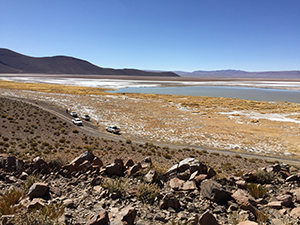
Salar de Rincon, Argentina. © BGS / UKRI.
The ‘Lithium Triangle’ technical visit organised by the UK’s Department for International Trade (DIT) representatives based in the Argentinian, Bolivian and Chilean British Embassies involving technical experts, UK stakeholders, in-country representatives and British Embassy staff, took place between the 7th and 14th May 2022. It involved visiting three salars, one in each of the Lithium Triangle countries, with the aim of understanding how these systems work, how they are being developed to produce lithium from brines contained under the salars and the main approaches in each country.
The main journey was made by bus starting from the collection point in Salta, Argentina. Once the attendees had assembled, on Monday 9th May a day trip was arranged to Salar de Rincon. This was hosted by Rio Tinto and a main group were given a tour of the facilities on the salar including being shown the operations on the salar itself. A separate, smaller group, travelled the other side of the salar and shown the lagunas (ponds where flamingos live and breed). The following day, Tuesday 10th May, saw the group driving from Salta to San Pedro de Atacama, Chile. Wednesday 11th May consisted of a visit to the Salar de Atacama to be given a tour of Albemarle’s facilities, one of the operators on the salar. The final leg of the journey to Bolivia, Thursday 12th May, involved a drive across the Bolivian border to Uyuni. Friday 13th May involved a visit to the Salar de Uyuni where a number of presentations were made on the Bolivian experience of operating salars. BGS staff stayed on in Bolivia to take part in a reconnaissance visit to determine field sites for a planned visit to both Salar de Atacama and Uyuni later on this year.
The trip enabled the BGS staff on the LiFT project to enhance their knowledge, talk to the relevant stakeholders as well as being able to plan the next phase of fieldwork. It was a highly useful and worthwhile exercise. We thank the operators allowing us access to their salars and the DIT staff at the British Embassies for organising this trip and for their unwavering good humour throughout the trials and tribulations.
Dr Kathryn Goodenough was recently interviewed by the Innovation News Network. In the interview she discusses the global importance of lithium, the aims of the LiFT project and innovations in mining and mineral processing technologies.
Read the Exploring the world’s sustainable lithium resources interview
The LiFT project held its first hybrid project meeting on the 2nd December 2021. The in-person aspect was held at the Surgeons Quarter in Edinburgh with ~30 people attending, with similar numbers participating online. Participants included the LiFT project team, project partners, advisory board members and other guests. The day was chaired by LiFT PI Kathryn Goodenough (British Geological Survey) while Bryne Ngwenya (University of Edinburgh) facilitated the online chat.
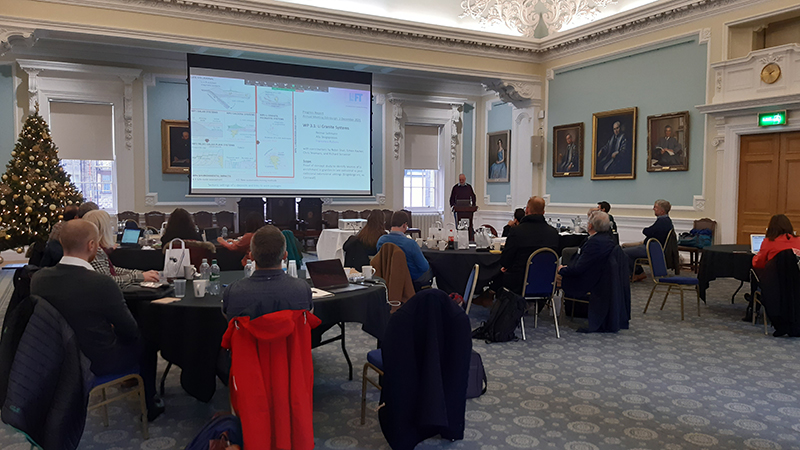
Robert Colbourn (Benchmark Mineral Intelligence) started the day with an overview of the current lithium market and trends, highlighting that the lithium deficit predicted for the mid-2020s is on course to be as big as the total 2015 lithium market. This was followed by an overview of the work being undertaken by WP1, given by Andrew Hughes and Jafar Al-Jawad (British Geological Survey), presenting work on the zonation, and interaction both within and between zones of salars.
A short break was followed by a talk by Jon Russill (SRK Exploration) on lithium exploration, highlighting how current exploration is still dominated by gold exploration and proposing how a new business model for junior explorers could help tackle some of the challenges facing the mining industry. Richard Herrington and Francesco Putzolu (Natural History Museum) and Marie Lefebvre-Desanois (University of Southampton) then gave an update on their mineralogy work being done as part of WP2 in the Jadar, McDermitt and Bigadiç regions.
The second half of the day began with Chris Yeomans (Cornish Lithium) giving an update on Cornish Lithium, including the recent announcement of their maiden JORC resource estimate for the Trelavour Project. Reimar Seltmann (Natural History Museum) and Kathryn Goodenough (British Geological Survey) of WP3 then gave updates about their work investigating the source of Li in granite, with fieldwork in Cornwall completed in the summer, and pegmatite systems, with fieldwork planned in Africa, respectively.
The afternoon session started with a talk about the social impacts of lithium in South America by Daniela Sanchez-Lopez (University of Cambridge), drawing attention to how lithium extraction from salars in South America affects ~2.8 million people, including 842 indigenous communities. The final update was given by Laura Newsome, Alastair Skeffington, Becca Kirk and Rowan Halkes (University of Exeter) of WP4. The two former gave outlines of their ongoing and planned geomicrobiological work, and the latter gave an update on the plan for Life Cycle Assessment work on the different types of lithium deposits. Finally, the Advisory Board members provided valuable commentary on the work of the project so far.
All those who participated agreed on how important meetings like this are in bringing research and industry together to help solve problems the Energy Transition poses. We all look forward to the next one!
Rowan Halkes
The BGS has released a report reviewing known resources of lithium, and engagement in the battery supply chain, across key African countries. Many African countries have lithium resources and the potential for lithium mines, and this report summarises available information as of July 2021. There is clear potential for Africa’s lithium resources to make an important contribution to regional economies, but this needs to be placed in the context of wider supply chains and environmental, social and governance issues. http://nora.nerc.ac.uk/id/eprint/530698
LiFT co-Investigator, Richard Herrington, has published a Comment article in Nature Reviews Materials on ‘Mining our Green Future’. In the article he highlights the importance of mining to supply the raw materials needed for green technology, including lithium. He points out the importance of having diverse sources of these raw materials, from both mining and recycling, and notes that "we must carefully balance the need to mine with the requirement to tackle environmental and social governance issues and to deliver sustainable development goals". The BBC has followed up with an article pointing out that the move to net zero inevitably means more mining, and emphasising the importance of lithium.
The LiFT project kicked off with a virtual meeting on January 21st, 2021. The meeting was divided into two sessions, the first addressing solid-rock lithium deposits, and the second addressing brine deposits and the environmental impacts of lithium mining. Altogether, the online sessions were attended by about 50 people, including the team working on the LiFT project, project partners, advisory board members and guests.
The first session started with an introduction from Kathryn Goodenough (British Geological Survey) who is the Principal Investigator for the LiFT project, followed by an overview of the current situation in the lithium markets from Dominic Wells (Roskill). Introductions to the two solid-rock work packages in LiFT followed, with Martin Palmer (University of Southampton) summarising planned work on the sediment-hosted deposits, whilst Reimar Seltmann (Natural History Museum) and Kathryn Goodenough gave an overview of anticipated research on granites and pegmatites. Subsequently we heard from Jorge Garcia (Rio Tinto) about the Jadar deposit in Serbia, and from Peter Walker (Lepidico) about the Karibib deposit in Namibia. The session ended with a short Q&A, chaired by Richard Herrington (Natural History Museum). A key point arising from the discussion was the importance of understanding mineralogical variation in these deposits, because this variability has a major impact on mineral processing and the potential to produce battery-grade chemicals.
The second session of the meeting began with Andrew Hughes (British Geological Survey) summarising the work to be done in the brines work package of LiFT, and Karen Hudson-Edwards (University of Exeter) talking about plans to investigate environmental impact. The latter work package includes both geomicrobiological research to investigate more sustainable methods for extracting lithium, and life-cycle analysis. Rob Pell (Minviro) then spoke in more detail about applying life-cycle analysis to the lithium industry, before Scott Hynek (US Geological Survey) gave an excellent overview of ongoing research at brine- and sediment-hosted lithium deposits in the USA. The session-ending Q&A was chaired by Bryne Ngwenya (University of Edinburgh) and a key point was the concept of coupled systems – it is vital to understand not just the lithium deposits that we see today, but also the processes by which lithium is mobilised, transported and concentrated in the crust. Many of these processes will be common to all the different deposit types. Finally, Simon Moores (Benchmark Minerals) pointed out that the industry’s timescale is now very short – research needs to contribute toward the opening of new mines in a timescale of less than a decade. It’s clear that LiFT research is timely!
Scientists at the British Geological Survey (BGS) will lead a new £2.5m NERC-funded research project designed to increase our understanding of global lithium resources to support a low carbon future.
BGS news, 27/11/2020